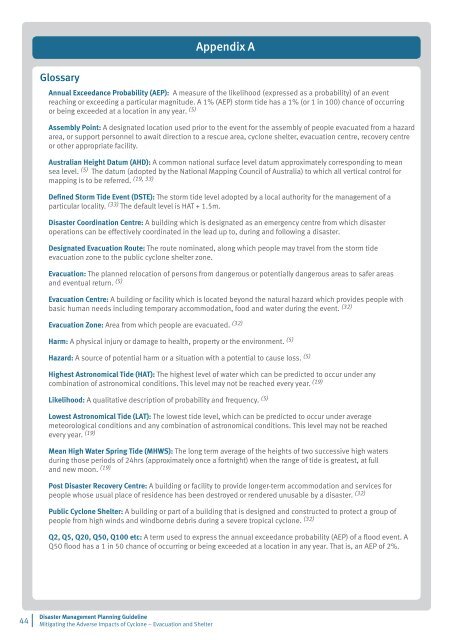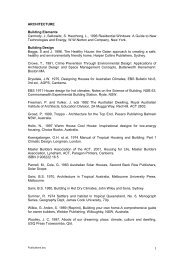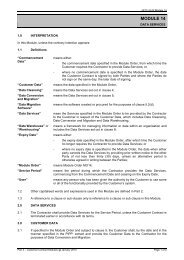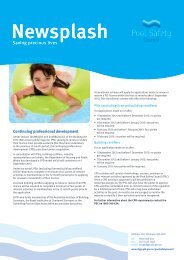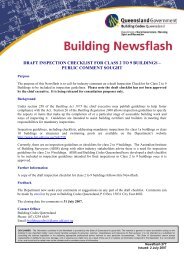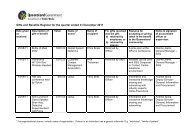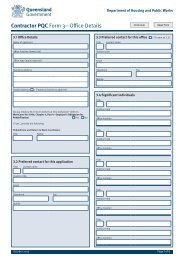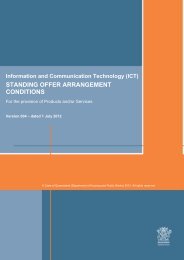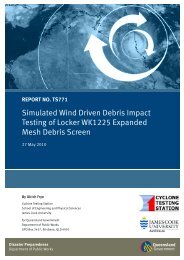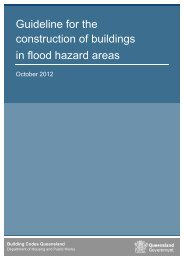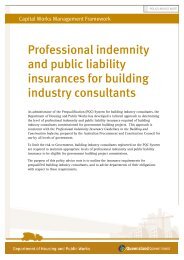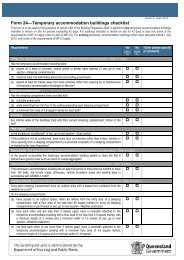Guideline - Department of Housing and Public Works - Queensland ...
Guideline - Department of Housing and Public Works - Queensland ...
Guideline - Department of Housing and Public Works - Queensland ...
You also want an ePaper? Increase the reach of your titles
YUMPU automatically turns print PDFs into web optimized ePapers that Google loves.
Appendix A<br />
Glossary<br />
Annual Exceedance Probability (AEP): A measure <strong>of</strong> the likelihood (expressed as a probability) <strong>of</strong> an event<br />
reaching or exceeding a particular magnitude. A 1% (AEP) storm tide has a 1% (or 1 in 100) chance <strong>of</strong> occurring<br />
or being exceeded at a location in any year. (5)<br />
Assembly Point: A designated location used prior to the event for the assembly <strong>of</strong> people evacuated from a hazard<br />
area, or support personnel to await direction to a rescue area, cyclone shelter, evacuation centre, recovery centre<br />
or other appropriate facility.<br />
Australian Height Datum (AHD): A common national surface level datum approximately corresponding to mean<br />
sea level. (5) The datum (adopted by the National Mapping Council <strong>of</strong> Australia) to which all vertical control for<br />
mapping is to be referred. (19, 33)<br />
Defined Storm Tide Event (DSTE): The storm tide level adopted by a local authority for the management <strong>of</strong> a<br />
particular locality. (33) The default level is HAT + 1.5m.<br />
Disaster Coordination Centre: A building which is designated as an emergency centre from which disaster<br />
operations can be effectively coordinated in the lead up to, during <strong>and</strong> following a disaster.<br />
Designated Evacuation Route: The route nominated, along which people may travel from the storm tide<br />
evacuation zone to the public cyclone shelter zone.<br />
Evacuation: The planned relocation <strong>of</strong> persons from dangerous or potentially dangerous areas to safer areas<br />
<strong>and</strong> eventual return. (5)<br />
Evacuation Centre: A building or facility which is located beyond the natural hazard which provides people with<br />
basic human needs including temporary accommodation, food <strong>and</strong> water during the event. (32)<br />
Evacuation Zone: Area from which people are evacuated. (32)<br />
Harm: A physical injury or damage to health, property or the environment. (5)<br />
Hazard: A source <strong>of</strong> potential harm or a situation with a potential to cause loss. (5)<br />
Highest Astronomical Tide (HAT): The highest level <strong>of</strong> water which can be predicted to occur under any<br />
combination <strong>of</strong> astronomical conditions. This level may not be reached every year. (19)<br />
Likelihood: A qualitative description <strong>of</strong> probability <strong>and</strong> frequency. (5)<br />
Lowest Astronomical Tide (LAT): The lowest tide level, which can be predicted to occur under average<br />
meteorological conditions <strong>and</strong> any combination <strong>of</strong> astronomical conditions. This level may not be reached<br />
every year. (19)<br />
Mean High Water Spring Tide (MHWS): The long term average <strong>of</strong> the heights <strong>of</strong> two successive high waters<br />
during those periods <strong>of</strong> 24hrs (approximately once a fortnight) when the range <strong>of</strong> tide is greatest, at full<br />
<strong>and</strong> new moon. (19)<br />
Post Disaster Recovery Centre: A building or facility to provide longer-term accommodation <strong>and</strong> services for<br />
people whose usual place <strong>of</strong> residence has been destroyed or rendered unusable by a disaster. (32)<br />
<strong>Public</strong> Cyclone Shelter: A building or part <strong>of</strong> a building that is designed <strong>and</strong> constructed to protect a group <strong>of</strong><br />
people from high winds <strong>and</strong> windborne debris during a severe tropical cyclone. (32)<br />
Q2, Q5, Q20, Q50, Q100 etc: A term used to express the annual exceedance probability (AEP) <strong>of</strong> a flood event. A<br />
Q50 flood has a 1 in 50 chance <strong>of</strong> occurring or being exceeded at a location in any year. That is, an AEP <strong>of</strong> 2%.<br />
44 |<br />
Disaster Management Planning <strong>Guideline</strong><br />
Mitigating the Adverse Impacts <strong>of</strong> Cyclone – Evacuation <strong>and</strong> Shelter


